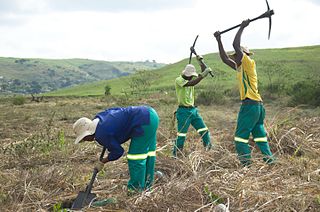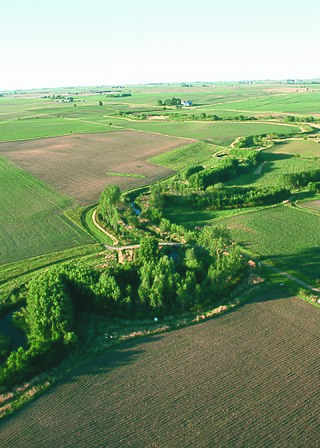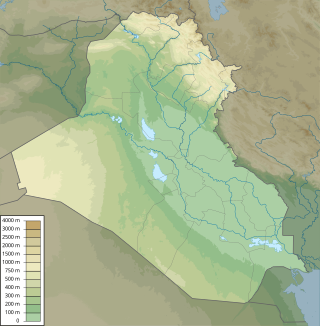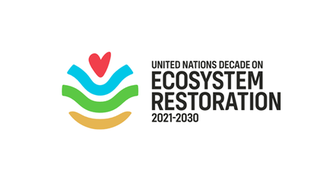
Ecological restoration, or ecosystem restoration, is the process of assisting the recovery of an ecosystem that has been degraded, damaged, destroyed or transformed. It is distinct from conservation in that it attempts to retroactively repair already damaged ecosystems rather than take preventative measures. Ecological restoration can reverse biodiversity loss, combat climate change, support the provision of ecosystem services and support local economies. The United Nations has named 2021-2030 the Decade on Ecosystem Restoration.
Environmental issues in Pakistan include air pollution, water pollution, noise pollution, climate change, pesticide misuse, soil erosion, natural disasters, desertification and flooding. According to the 2020 edition of the environmental performance index (EPI) ranking released by Yale Center for Environmental Law & Policy, Pakistan ranks 142 with an EPI score of 33.1, an increase of 6.1 over a 10-year period. It ranked 180 in terms of air quality. The climatic changes and global warming are the most alarming issues risking millions of lives across the country. The major reasons of these environmental issues are carbon emissions, population explosion, and deforestation.

Stream restoration or river restoration, also sometimes referred to as river reclamation, is work conducted to improve the environmental health of a river or stream, in support of biodiversity, recreation, flood management and/or landscape development.

Wetland conservation is aimed at protecting and preserving areas of land including marshes, swamps, bogs, and fens that are covered by water seasonally or permanently due to a variety of threats from both natural and anthropogenic hazards. Some examples of these hazards include habitat loss, pollution, and invasive species. Wetland vary widely in their salinity levels, climate zones, and surrounding geography and play a crucial role in maintaining biodiversity, ecosystem services, and support human communities. Wetlands cover at least six percent of the Earth and have become a focal issue for conservation due to the ecosystem services they provide. More than three billion people, around half the world's population, obtain their basic water needs from inland freshwater wetlands. They provide essential habitats for fish and various wildlife species, playing a vital role in purifying polluted waters and mitigating the damaging effects of floods and storms. Furthermore, they offer a diverse range of recreational activities, including fishing, hunting, photography, and wildlife observation.
The Basin Focal Projects (BFPs) are a set of CGIAR Challenge Program on Water and Food projects aimed at identifying and catalyzing the implementation of strategic interventions to enhance human and ecological well-being through increases in river basin and local level water productivity.

Forest restoration is defined as "actions to re-instate ecological processes, which accelerate recovery of forest structure, ecological functioning and biodiversity levels towards those typical of climax forest", i.e. the end-stage of natural forest succession. Climax forests are relatively stable ecosystems that have developed the maximum biomass, structural complexity and species diversity that are possible within the limits imposed by climate and soil and without continued disturbance from humans. Climax forest is therefore the target ecosystem, which defines the ultimate aim of forest restoration. Since climate is a major factor that determines climax forest composition, global climate change may result in changing restoration aims. Additionally, the potential impacts of climate change on restoration goals must be taken into account, as changes in temperature and precipitation patterns may alter the composition and distribution of climax forests.

Mangrove restoration is the regeneration of mangrove forest ecosystems in areas where they have previously existed. Restoration can be defined as "the process of assisting the recovery of an ecosystem that has been degraded, damaged, or destroyed." Mangroves can be found throughout coastal wetlands of tropical and subtropical environments. Mangroves provide essential ecosystem services such as water filtration, aquatic nurseries, medicinal materials, food, and lumber. Additionally, mangroves play a vital role in climate change mitigation through carbon sequestration and protection from coastal erosion, sea level rise, and storm surges. Mangrove habitat is declining due to human activities such as clearing land for industry and climate change. Mangrove restoration is critical as mangrove habitat continues to rapidly decline. Different methods have been used to restore mangrove habitat, such as looking at historical topography, or mass seed dispersal. Fostering the long-term success of mangrove restoration is attainable by involving local communities through stakeholder engagement.

The Climate and Development Knowledge Network (CDKN) works to enhance the quality of life for the poorest and most vulnerable to climate change. CDKN does this by combining research, advisory services and knowledge management in support of locally owned and managed policy processes. It works in partnership with decision-makers in the public, private and non-governmental sectors nationally, regionally and globally.

Malik Amin Aslam is a Pakistani environmentalist and politician who served as Federal Minister of State for Environment from 2004-2007 in the cabinet of Prime Minister Shukat Aziz https://www.cabinet.gov.pk/SiteImage/Misc/files/Federal%20Cabinet%201947/24%20Shaukat%20Aziz%2C%2028-08-2004%20to%2015-11-2007.pdf/and later as Federal Minister and Adviser to former Prime Minister of Pakistan Imran Khan for Climate Change. He also serves as Vice President in IUCN.
Climate resilience is a concept to describe how well people or ecosystems are prepared to bounce back from certain climate hazard events. The formal definition of the term is the "capacity of social, economic and ecosystems to cope with a hazardous event or trend or disturbance". For example, climate resilience can be the ability to recover from climate-related shocks such as floods and droughts. Different actions can increase climate resilience of communities and ecosystems to help them cope. They can help to keep systems working in the face of external forces. For example, building a seawall to protect a coastal community from flooding might help maintain existing ways of life there.

Conservation in Pakistan is the act of preserving, guarding, or protecting, biodiversity, environment, and natural resources of Pakistan.

The Buffelsdraai Community Reforestation Project was initiated in 2008 to alleviate climate change impacts associated with hosting elements of the 2010 FIFA World Cup in Durban. The proposed carbon offset was to be achieved through the planting of more than 500 000 indigenous trees within the buffer zone of the Buffelsdraai Landfill Site. Restoring the forest ecosystem was identified as a way of "absorbing event-related greenhouse gas emissions while enhancing the capacity of people and biodiversity to adapt to the inevitable effects of climate change".

Nature-based solutions describe the development and use of nature (biodiversity) and natural processes to address diverse socio-environmental issues. These issues include climate change mitigation and adaptation, human security issues such as water security and food security, and disaster risk reduction. The aim is that resilient ecosystems provide solutions for the benefit of both societies and biodiversity. The 2019 UN Climate Action Summit highlighted nature-based solutions as an effective method to combat climate change. For example, nature-based systems for climate change adaptation can include natural flood management, restoring natural coastal defences, and providing local cooling.

Climate change education (CCE) is education that aims to address and develop effective responses to climate change. It helps learners understand the causes and consequences of climate change, prepares them to live with the impacts of climate change and empowers learners to take appropriate actions to adopt more sustainable lifestyles. Climate change and climate change education are global challenges that can be anchored in the curriculum in order to provide local learning and widen up mindset shifts on how climate change can be mitigated. In such as case CCE is more than climate change literacy but understanding ways of dealing with climate
The Global Peatlands Initiative is an effort made by leading experts and institutions formed in 2016 by 13 founding members at the UNFCCC COP in Marrakech, Morocco. The mission of the Initiative is to protect and conserve peatlands as the world's largest terrestrial organic carbon stock and to prevent it from being emitted into the atmosphere.

In Iraq, climate change has led to environmental impacts such as increasing temperatures, decreasing precipitation, land degradation, and water scarcity. Climate change poses numerous risks to human health, livelihoods, political stability, and the sustainable development of the nation. The combination of ecological factors, conflict, weak governance, and an impeded capacity to mitigate climate change, has made Iraq uniquely at risk to the negative effects of climate change, with the UN ranking them the 5th most vulnerable country to climate change. Rising temperatures, intensified droughts, declining precipitation, desertification, salinization, and the increasing prevalence of dust storms are challenges Iraq faces due in to the negative impacts of climate change. National and regional political instability and conflict have made it difficult to mitigate the effects of climate change, address transnational water management, and develop sustainably. Climate change has negatively impacted Iraq's population through loss of economic opportunity, food insecurity, water scarcity, and displacement.

The United Nations Decade on Ecosystem Restoration runs from 2021 to 2030. Similar to other nature related international decades, its purpose is to promote the United Nations’ environmental goals. Specifically, to facilitate global cooperation for the restoration of degraded and destroyed ecosystems. Along with fostering efforts to combat climate change, safeguard biodiversity, food security, and water supply. While much focus is on promoting restoration activity by national governments, the UN also wishes to promote such efforts from other actors, ranging from the private sector and NGOs to regular individuals.
Ecosystem-based adaptation encompasses a broad set of approaches to adapt to climate change. They all involve the management of ecosystems and their services to reduce the vulnerability of human communities to the impacts of climate change. The Convention on Biological Diversity (CBD) defines EBA as "the use of biodiversity and ecosystem services as part of an overall adaptation strategy to help people to adapt to the adverse effects of climate change".
The Occidental Arts & Ecology Center (OAEC) is a non-profit organization and intentional community located near the town of Occidental in the western part of Sonoma County, California, the traditional homeland of the Southern Pomo and Coast Miwok. It is situated on an 80-acre ecological reserve in the Dutch Bill Creek Watershed, near the Russian River. OAEC is a research, demonstration, education, advocacy, and community-organizing center that develops strategies for regional-scale community resilience.
Agro-Climatic Resilience in Semi-Arid Landscapes (ACReSAL) is a six-year project funded by the World Bank, aimed at restoring degraded landscapes in Northern Nigeria. The region is marked by significant challenges, including high poverty rates, low literacy levels, and an environment of fragility, conflict, and violence. The degradation of natural resources, poor agricultural productivity, and climate risks like desertification further complicate the situation. Additionally, the area suffers from poor penetration of modern technology and weak institutional capacity.














